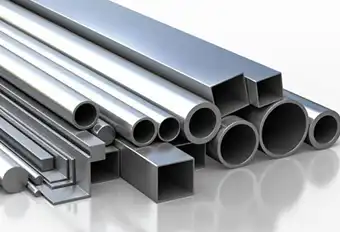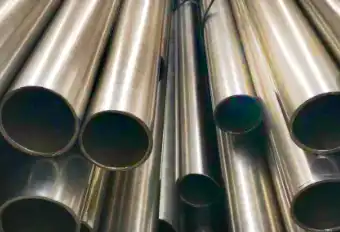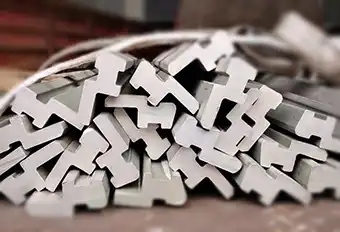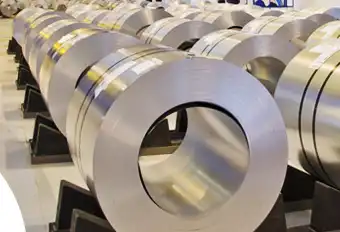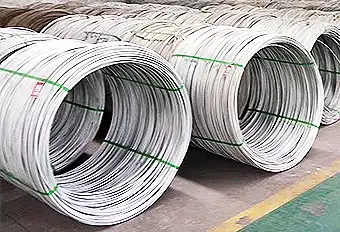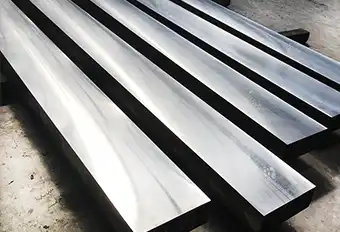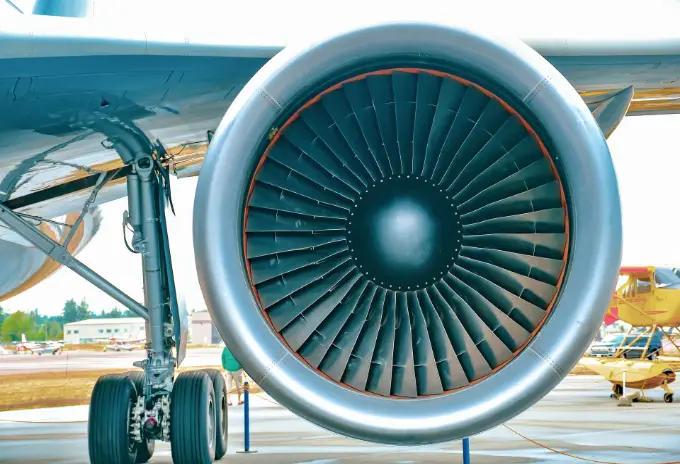Hot deformation behavior of a 15Cr-25Ni-Fe based alloy and corresponding process
The application of non-quenched/tempered (NQ/T) steel in the high-grade hot-rolling seamless steel oil-well tubes is a new field. The tube manufacture process mainly consists of the following thermo-mechanical stages: piercing, tube-rolling, controlled cooling, reheating, stretch-reduction-diameter and cooling. However, no systematical research has been reported on the microstructure evolution and the strengthening/toughening of the high-grade hot-rolling seamless steel oil-well tubes produced by medium carbon microalloyed steel. In this dissertation, based on a real manufacture process of N80 grade hot-rolling NQ/T seamless steel oil-well tubes, the microstructure development, precipitation behavior and ferrite grain refinement in steel 33Mn2V during the above process were investigated. The precipitation and dissolution in steel 33Mn2V were studied through both the numerical calculation and the stress relaxation method. The precipitation-temperature-time curve was determined in austenite range of 600°C~950°C using the stress relaxation method on a Gleeble 2000 thermal/dynamic simulator. The curve is double C-shaped, with minimum incubation time of about 4.5 seconds at 850°C and about 3.8 seconds at 650°C, respectively. The obtained results provide important evidences for better understanding of the precipitation behavior in steel 33Mn2V at different stages during the real manufacture process of N80 grade hot-rolling NQ/T seamless steel oil-well tubes. Combined with various research methods, the microstructure evolution in steel 33Mn2V under different processing conditions was studied. The results have shown that the average austenite grain size in steel 33Mn2V would almost always continuously increase in the tube manufacture process till just before the stretch-reduction-diameter deformation. It is not consistent with the assumption that the austenite grains are gradually refined both by double dynamic recrystallization during the piercing, tube-rolling process, and the “in-line-normalization” produced when the tubes cooled down to Ar1 and reheating. The most effective microstructure refinement is produced during the austenite decomposition after stretch-reduction-diameter deformation. It has been found that the stop temperature (Ts) of controlled cooling following tube-rolling, the composition homogeneity of tube billet, and the cooling rate after stretch-reduction-diameter have strong influence on the final microstructure. Two values of Ts were used in our experiments: 850°C and 600°C. The industrial technical routines using Ts = 600°C, which is still above Ar3, would finally lead to microstructure with finer ferrite and pearlite, while the technical routines using Ts = 850°C were likely to result in microstructure consisting of ferrite, pearlite and bainite. The reason is that finer C-rich carbonitrides would form in the intermediate cooling process down to 600°C and in the reheating process, until the austenite decomposition starts in the final cooling process. The lowering of both carbon and alloying content in austenite and the uniformly distributed fine precipitation particles in austenite promote ferrite formation, especially inside austenite grains. This is quite different from that resulted from the austenite refinement principle. Based on the experimental results obtained from both the laboratory simulation and the industrial experiment, a microstructure refinement mechanism controlled by austenite decomposition characteristics resulted by vanadium precipitation during the processes after tube-rolling was firstly proposed and verified. The microstructure examination and mechanical tests of hot-rolled seamless tube samples obtained from industrial investigation were quantitatively analyzed. It is easily found that bainite (B) and B-like constituents in the microstructure are extremely harmful to the impact toughness of the steel, and that the microstructure bearing high volume fraction of ferrite (F) and bearing no B and B-like constituents almost always leads to high impact energy at 0°C. These results grain again support the microstructure refinement mechanism proposed in this work.
As part of a Heavy Gas Turbine Project, the task of this research is to design the hot
working processes of outsize turbine disk used for heavy gas turbine, the diameter of which is
over 2 meters and the weight is over 4 tones. As the GH2674 alloy used is new in China, its hot
deformation behavior was studied systemically at first to obtain the temperature and strain rate
range which suit the constitutive requirements of this alloy from view point of optimum
workability and microstructural control for hot working. On this basis, combined with the actual
manufacture condition, the forging process of this type of outsize turbine disk billet was
researched and designed by numerical simulation technique (FEM).
By hot compressing testing on a Gleeble-1500 simulator, the true stress-true strain curves
were obtained and the hot deformation behavior of GH2674 in the temperature range of 950-
1200 and strain rate range of 0.001 ℃ -10 s-1 was studied. The results show that, the flow stress is
very sensitive to strain rate, less sensitive to temperature and not sensitive to strain. Flow stress
in hot deformation can be related to strain rate and temperature through an Arrhenius type of
rate equation
It is noticeable that this equation has offered no information on deformation mechanisms of
the alloy. So it does not specifically lead to optimization of intrinsic workability. Therefore the
processing map of dynamic materials model (DMM) has been used to reveal the deformation
mechanism and microstructure evolution.
On the basis of the hot compressing experimental data and by using the principles of DMM,
the processing map of GH2674 alloy was developed in the temperature range of 950-1200℃
and the strain rate range of 0.001-10 s-1. The map exhibits two important domains, with their
peaks locating at 1040 and 1 ℃ 0 s-1 with a peak efficiency of power dissipation of 38%, and at
1075 and ℃ 0.04s-1 with a peak efficiency of 40%, respectively. On the basis of optical
microscopic observations, the two domains are interpreted to represent two dynamic
recrystallization (DRX) domains with different mechanisms. The map also exhibits a long
concave band in the temperature range of 1075-1100℃,which may be related to the
solutionizing of M3B2 phase. At temperatures lower than 1000 and strain rates higher than ℃
0.1s-1, the material may be subjected to potential instabilities, while at temperatures higher than
1050 and str ℃ ain rates lower than 0.01s-1, the material exhibits significant grain coarsening.
Furthermore, the wedge cracking would appear at 1200 and 0.001s ℃ -1
As the DRX is the main softening mechanism and corresponds to the important
microstructural reconstruction during hot deformation, the above two DRX domains are the
workable range of GH2674 alloy. Therefore, study on the DRX mechanism and hot
deformation behavior of this alloy with different temperatures and strain rates was further
carried out. Due to the strain rate differenence of the two DRX domains, their DRX nucleation sites and
rates are also different, which lead to different control mechanisms of the DRX process. In the
lower strain rate DRX domain, the process is mainly controlled by the nucleation process; in the
higher strain rate one, the process is mainly controlled by the growth process. As a result,
different microstructures would form corresponding to the two DRX domains. The deformation
temperature has the effects on the DRX through two ways. First, the increase of temperature
leads to the decrease of the N/G value of the DRX and, furthermore, leads to the increase of
average DRX grain size; second, the deformation temperature has a great effect on the
completeness of the DRX, which can influence the microstructure after solution treatment.
On the basis of the constitutive behavior of GH2674 alloy as revealed above, the relation
between the hot deformation parameter and the mechanism can be established, and the hot
working schedules were designed primarily. The process should be controlled so that the local
values of temperature and strain rate fall within the DRX domains, and the undesirable regimes
such as flow instability or cracking are avioded. On the basis of the strain rate of the available
hot pressing equipment in China at present, it is suitable to product sheets, bars and disks of
GH2674 alloy by rolling, extruding and hammer forging in DRXⅠdomain; while the outsize
disks are better upsetted by hydraulic pressing in DRXⅡdomain.
After the hot workability studied, further research work were conducted to design the key
process, i.e. the hot upsetting process, of the outsize GH2674 alloy turbine disk billet using FE
simulation technique. The load force and the distribution of the temperature and strain were
analyzed under different process conditions. Then the typical deformation areas in the forged
pieces were identified. By limiting these typical areas’ deformation temperature-strain rate
trajectories within the DRXⅡdomain, the optimum parameters of the hydraulic pressing
process were designed for the upsetting process of the outsize turbine disk billets


